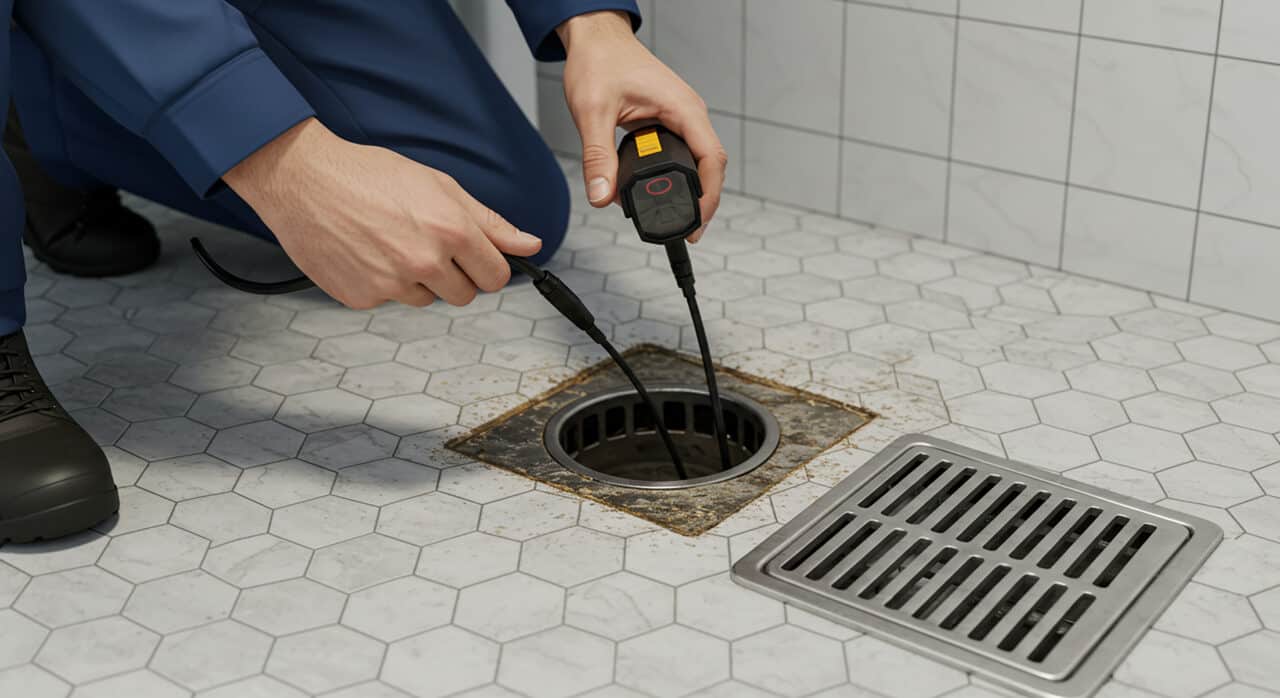Every facility has a weak point. And when it comes to commercial plumbing, the sewer line tends to be it. One slow drain turns into a full-on backup. Suddenly, you’re dealing with bad smells, tenant complaints, and unexpected downtime.
Sewer issues are among the most common plumbing problems in commercial buildings — and one of the most preventable. Lee Company has helped hospitals, restaurants, warehouses, and other facilities across the Southeast stay ahead of these problems since 1944. This guide explains how often to schedule commercial sewer cleaning, what drives the timeline, and how to stop chasing emergencies.
Factors That Affect Commercial Sewer Cleaning Frequency
No two facilities use their plumbing systems the same way. A stadium restroom on game day doesn’t operate like an office building on a Tuesday. Your sewer-cleaning schedule should reflect that.
Before deciding how often sewer lines should be cleaned, you need to account for what’s flowing through them, how often, and what kind of system you’re working with.
Type of Business
Certain businesses generate more waste and more risk:
- Restaurants push fats, oils, and grease (FOG) through the system daily.
- Hospitals and labs flush chemicals and sanitation waste.
- Industrial plants may discharge debris, sludge, or non-organic materials.
That’s a recipe for blockages without a proactive plan. Sewer-related problems account for 5% of all commercial insurance claims, making them one of the most common facility headaches.
Pipe Material & Age
What’s underground matters. Clay and cast iron systems are especially vulnerable to scale buildup, root intrusion, and corrosion. The older the pipe, the more frequently it needs attention. According to Verified Market Research, aging infrastructure is one of the top drivers behind the rising demand for commercial drain and sewer cleaning. That’s been our experience as well.
Usage Volume
It’s not just what goes in. It’s how much.
- Large offices, shopping malls, airports, and schools generate constant use.
- Multi-tenant buildings multiply the strain.
More daily use means faster accumulation of debris and higher cleaning frequency.
History of Issues
If your building has seen:
- Tree root intrusion…
- Chronic slow drains…
- Previous sewer backups…
Then a one-size-fits-all cleaning cycle won’t cut it. You’ll need a customized, preventive schedule from a commercial sewer cleaning company that knows your history and how to avoid a repeat.
Recommended Sewer Cleaning Schedule
No matter what your building is used for, sewer line cleaning isn’t a one-and-done service. It’s a recurring part of protecting your operations, avoiding high cleanup costs, and keeping plumbing systems moving.
Ignoring plumbing maintenance can get expensive fast. Cleanup costs after a backup range from $2,000 to $10,000, and in extreme cases, up to $50,000.
How often should sewer lines be cleaned? It depends on your risk factors.
High-Usage Facilities: Every 3–6 Months
Restaurants, hospitals, manufacturing plants, and other high-waste facilities require the most frequent cleanings. These buildings see constant use, with high volumes of grease, solids, or chemical discharge running through the pipes.
Moderate-Use Buildings: Every 6–12 Months
Offices, retail spaces, and mid-size commercial buildings fall into this category. If your tenants or staff use kitchens, restrooms, or janitorial sinks daily, once-a-year cleaning is the bare minimum.
Low-Use Buildings: Every 12–18 Months
Storage units, low-occupancy warehouses, and rarely-used facilities can go longer between cleanings. But don’t skip it entirely. Undetected buildup can still cause a sudden blockage or trap standing water.
Signs You Need Immediate Cleaning
Even the best-run facilities encounter warning signs between scheduled cleanings. Knowing which ones indicate a developing blockage rather than a one-off issue is key.
Watch for:
- Gurgling or bubbling in floor drains or toilets. This often means air is being displaced by a partial obstruction deeper in the system.
- Unexplained slow drainage in multiple fixtures across floors or units. This suggests the problem is in the main line, not just a localized clog.
- Backups during peak usage, like lunch hours in restaurants or shift changes in hospitals. These patterns point to restricted flow that can’t keep up with demand.
- Persistent sewer smells near janitor closets, basements, or lower-level restrooms. This may be caused by trapped wastewater or dry traps due to negative pressure.
- Wet areas near cleanouts or manholes, even during dry weather. This can signal that wastewater is backing up or the system is nearing capacity.
Benefits of Regular Commercial Sewer Cleaning
Facility managers don’t just need backup plans — they need to prevent the backup in the first place. Sewer systems are one of the few things in a facility that can go from “fine” to “failure” in minutes. Here’s where proactive cleaning stops being theoretical and starts saving you money, time, and major operational headaches.
Prevents Costly Repairs
Routine cleaning buys you something no insurance payout ever will: control. When clogs, fractures, or buildup are caught early, you can address them on your terms.
Regular cleaning clears debris before it hardens, reduces blockages in low-flow zones, and helps detect damaged pipes before they collapse. It also means fewer emergency calls, fewer after-hours invoices, and fewer days lost to cleanup and disruption.
Maintains Health & Sanitation Standards
Wastewater carries bacteria, odors, and airborne contaminants. Overflow in service corridors or near HVAC intake points creates exposure risks that can quickly escalate into OSHA violations or sanitation closures. Regular cleaning minimizes these hazards and keeps your facility safe and operational.
Improves System Longevity
Every system has a wear curve. Cleaning slows it. Removing corrosive buildup and preventing debris accumulation reduces stress on the pipe walls and connections. This extends the lifespan of your infrastructure and helps you avoid full-scale replacements.
Meets Regulatory Compliance
Many municipalities require documented wastewater system maintenance. Failure to show a cleaning history can lead to fines, permit delays, or liability in the event of a spill. A consistent maintenance schedule protects your facility and your records.
What Happens During a Professional Sewer Cleaning?
At Lee Company, we don’t show up with a guess. We show up with the right tools and a plan. Every commercial sewer cleaning starts with a high-definition video inspection. Our licensed technicians assess pipe material, slope, and flow conditions while identifying buildup, cracks, or intrusions. You get a full diagnostic report and footage for your records, whether for compliance, budgeting, or internal maintenance planning.
If cleaning is needed, we use hydro jetting with pressure calibrated to your system (not one-size-fits-all).
For older cast iron lines, we include descaling to remove corrosion without damaging the pipe. If roots are present, we mechanically clear them using sectional cutters.
Afterward, we perform a second camera inspection to confirm the line is clean and structurally sound.
For facilities with high usage or a history of issues, we can help create a customized cleaning schedule to reduce emergency calls and keep operations uninterrupted.
How Sewer Maintenance Fits Into a Larger Facilities Plan
When commercial sewer line cleaning is treated like a one-off reaction to a backup, you miss the bigger opportunity: visibility and control.
Planned sewer maintenance gives you both. It helps you anticipate issues, support budgeting cycles, and build capital plans with real data instead of guesswork.
At Lee Company, we build sewer inspections and cleanings into larger Facilities Management and Maintenance Plans that also cover HVAC, electrical, plumbing, and more. These integrated strategies help facility managers prioritize needs, reduce unplanned shutdowns, and stay compliant with municipal standards.
For example, a facility’s 5-year capital plan might include HVAC upgrades, roof replacement, and sewer rehab if you know which systems are nearing failure. Our diagnostic reports help drive those decisions.
Sewer maintenance is one of the easiest ways to turn deferred maintenance into proactive planning.
Benefits of including sewer service in your facilities plan:
- Avoid unbudgeted repairs or insurance gaps.
- Justify capital requests with inspection data.
- Sync plumbing timelines with other scheduled work.
Plumbing maintenance isn’t just for staying operational. It’s for staying ahead.
Municipal vs. Private Sewer Line Responsibility
When a sewer problem surfaces, the first question is often: Who’s responsible? Knowing the answer can save you hours of confusion and thousands in misdirected costs.
- Municipalities are typically responsible for the main sewer line beneath the street.
- Property owners are responsible for the lateral line that runs from your building to the connection point at the main.
This distinction matters most during emergencies. If wastewater is backing up inside your building, and the lateral line is to blame, it’s your responsibility to fix it, not the city’s.
At Lee Company, our video inspections are designed to pinpoint exactly where the problem starts. We document the source, whether it’s on your property or in the public right of way, so there’s no gray area when it’s time to act.
Choosing a Commercial Sewer Cleaning Company
Commercial plumbing isn’t a place to cut corners. Sewer systems in restaurants, hospitals, industrial plants, and campuses demand precision, experience, and 24/7 availability.
Start with experience and licensing. A commercial sewer-cleaning company must understand local codes, permit requirements, and system complexities. The wrong technician can cost you far more than just a second visit.
Look for companies that use modern tools like:
- Hydro jetting
- High-resolution camera inspections
- Trenchless repair capabilities
Downtime is expensive. You need a partner who can prevent it or respond fast when it’s unavoidable.
Our experienced commercial plumbers offer full-system diagnostics, routine sewer maintenance, and 24/7 emergency plumbing support across Tennessee, Alabama, Kentucky, and Georgia.
We don’t just clear blockages. We help you stay ahead of them with long-term planning and integrated facilities support.
Contact Lee Company to reduce risk, avoid unplanned downtime, and keep your plumbing systems running without surprises.


